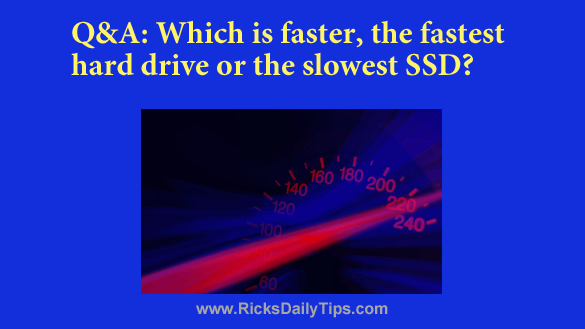
Want to get my easy to follow Tech Tips in your email?
Sign up for my daily Rick’s Tech Tips Newsletter!
Question from Rod: My friend and I were discussing the advancements that have been made in technology when an interesting question came to mind.
Are the fastest hard drives made today still slower than the slowest SSDs?
I say no, but my friend says yes.
Seems like I remember hearing that Seagate has already designed some new hard drives that are just as fast as SSDs, but maybe I heard that wrong.
If the answer is no, do you think they’ll ever be able to build a hard drive that’s as fast as an SSD?
Rick’s answer: That’s a great question, Rod. I’m glad you asked it, but I’m afraid your friend takes the prize on this one…
Truth be told, the fastest hard drives available today really are blazing speed demons compared to the hard drives from times past, thanks to a number of technological innovations. And truth be told, some of them boast read speeds that getting pretty close to what you would get with a standard SSD.
But that being said, even those fastest hard drives can’t quite match the read/write speeds of even the slowest current solid state drives.
Why? Because all spinning hard drives have two limiting factors that SSDs don’t have when it comes to speed:
1 – A hard drive’s read/write heads have to physically move in and out across the surfaces of the platters to find the track on the platter the heads needs to access, and that movement takes time (although that time is incredibly short).
2 – The heads also have to wait for the platters to spin around into the the correct position before they can even being reading or writing any data.
To illustrate how this motion works, here’s a short video that shows a hard drive’s read/write heads moving over the surfaces of its platters:
Again, while the time it takes for the heads and platters to move into the desired position is incredibly short, those delays still exist.
SSD’s by comparison don’t have any moving parts at all. Data can be read from or written to any memory cell on the entire drive immediately without having to wait for anything to physically move into position.
Will engineers ever be able to design a hard drive that’s as fast as an SSD? My best guess is no because SSD technology is advancing far faster than hard drive technology.
Truth be told, I believe it’s just a matter of time before spinning hard drives go the way of the dinosaur because large capacity SSDs are becoming ever more affordable for consumers.
FYI: Contrary to what the video said, most hard drives are NOT waterproof. They are dust-proof however, at least as long as the seal isn’t broken on the enclosure. (The only reason the cover was removed on this one is so we could see the internal parts of the drive in action.
Thanks again for the great question, Rod.